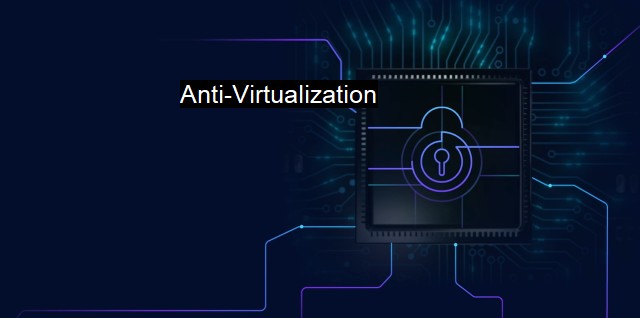What is Anti-Virtualization?
The Threat of Anti-Virtualization: Understanding Its Impact on Cybersecurity and Antivirus Systems
Anti-virtualization is a cybersecurity concept that denotes the use of malicious software to thwart virtualization techniques or escape virtual environments. it is an anti-analysis technique used by malware to detect and combat virtual environments that hinder their abilities or intentions as a protective measure. In the broader context of cybersecurity and antivirus, understanding anti-virtualization is crucial as it forms a significant aspect of advanced malware attacks.Virtualization is a powerful technology that's ubiquitous in the current age of computing. It encompasses the creation of a virtual environment or a simulation of a real system. Security professionals and researchers often work in isolated virtual environments to analyze malicious programs to ascertain threat vectors without risking the integrity of the primary system. The usage of virtual machines promises an efficient and safe procedure to reverse-engineer and comprehensively analyze the potential damage malware could provoke on a real system.
Having recognized the widespread use of virtual environments in antivirus testing and development, creators of malware have evolved their attacking techniques. Through anti-virtualization, these perpetrators attempt to bypass or alter execution within a virtual environment. When malware employs anti-virtualization strategies, it performs specific checks to verify whether it is being run within a virtual environment.
In case the malware detects its virtual environment, it either ceases its malicious activity entirely, thus masking its actual behavior, or it triggers an apparent system failure to distract from its actual objective. This technique allows it to fly under the radar of most antivirus software, giving it the chance to move beyond the virtual environment and compromise the host machine or network.
On the contrary, attacks employing the anti-virtualization methodology may engineer the malware to perform optimally within a physical environment. This antagonist can lay dormant when executed within a virtual machine environment, thus proving to be hard to detect using standard precautionary measures.
An effective anti-virtualization malware can detect numerous signs that it's in a virtualized environment. These can include the detection of specific set registry keys, processes, files, or even hardware-related information matching to known virtualization platforms such as VMware or VirtualBox. the malware might monitor the computer’s operation like mouse movements to confirm suspicions, as these inputs can sometimes seem less organic or ‘human’ in a controlled virtual environment.
Handling malware using anti-virtualization can be agonizingly challenging for cybersecurity experts. Conventional methods of monitoring and control are mostly ineffective. This leaves organizations and antivirus software developers with the uphill task of staying a step ahead of cybercriminals. It ultimately calls for constant security evaluation, up-to-date threat intelligence, and potentially developing more sophisticated and clandestine virtual environments to analyze such malware effectively imperceptibly.
This strategy against anti-virtualization must include proactive defense mechanisms like heuristic and behavior-based detection. Realistically, the war against malware using anti-virtualization is not winnable solely through reactive protection measures.
Anti-virtualization presents a sophisticated method that malware engages in evading detection and fighting and escaping virtual environments. It underpins the ongoing arms race between cybersecurity researchers and cybercriminals - a constant intellectual battle to keep, if not stay ahead, at least on par with cyberthreats. The problem of anti-virtualization also emphasizes the need for innovative thinking and constant vigilance in the cybersecurity domain.

Anti-Virtualization FAQs
What is "anti-virtualization" from a cybersecurity perspective?
Anti-virtualization refers to techniques used to bypass or evade virtualization-based security measures that are commonly used in antivirus software. These techniques are often used by malware authors to avoid detection and analysis.Why do malware authors use anti-virtualization techniques?
Malware authors often use anti-virtualization techniques to evade detection and analysis by security researchers and antivirus software. By detecting virtualization-based security measures, malware can avoid analysis and remain undetected.How do anti-virtualization techniques work?
Anti-virtualization techniques work by detecting virtual environments and disabling or evading security measures. This can involve checking for specific virtualization drivers, altering system messages, or executing specific code to detect and bypass virtualization-based security measures.What can be done to prevent anti-virtualization techniques?
To prevent anti-virtualization techniques, organizations should ensure that their antivirus software and security measures are regularly updated and patched. It's also important to employ additional security measures, such as intrusion detection systems and behavior-based analysis, to detect and prevent malware that may otherwise evade virtualization-based security measures.| | A | | | B | | | C | | | D | | | E | | | F | | | G | | | H | | | I | | | J | | | K | | | L | | | M | |
| | N | | | O | | | P | | | Q | | | R | | | S | | | T | | | U | | | V | | | W | | | X | | | Y | | | Z | |
| | 1 | | | 2 | | | 3 | | | 4 | | | 7 | | | 8 | | |||||||